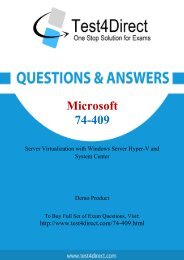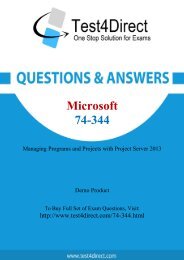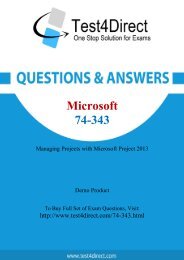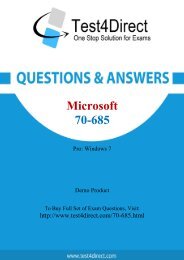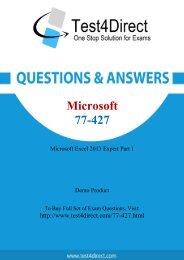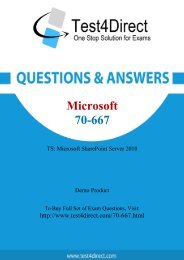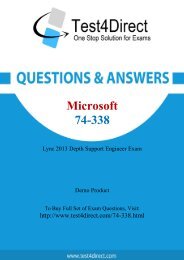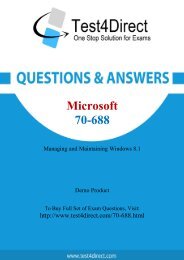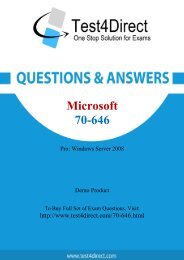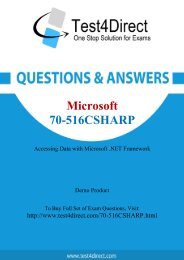70-981 BrainDumps Discount
Test4Direct provides latest PDF questions of Microsoft 70-981 exam. You have an opportunity to pass the Microsoft 70-981 exam in one go. Test4Direct is most accurate source to prepare Microsoft 70-981 exam as your success will become site’s responsibility after purchasing 70-981 exam product. There are also lots of discounts and promotion offers that you can avail. Let’s try a free demo http://www.test4direct.com/70-981.html
Test4Direct provides latest PDF questions of Microsoft 70-981 exam. You have an opportunity to pass the Microsoft 70-981 exam in one go. Test4Direct is most accurate source to prepare Microsoft 70-981 exam as your success will become site’s responsibility after purchasing 70-981 exam product. There are also lots of discounts and promotion offers that you can avail. Let’s try a free demo http://www.test4direct.com/70-981.html
Create successful ePaper yourself
Turn your PDF publications into a flip-book with our unique Google optimized e-Paper software.
Microsoft<br />
<strong>70</strong>-<strong>981</strong><br />
Recertification for MCSE: Private Cloud<br />
Demo Product<br />
To Buy Full Set of Exam Questions, Visit:<br />
http://www.test4direct.com/<strong>70</strong>-<strong>981</strong>.html
Question: 1<br />
You have a System Center 2012 R2 infrastructure.<br />
You plan to implement the Audit Collection Service (ACS). ACS reports will not be available from the<br />
Operations Manager console. You need to recommend a solution to view the ACS reports. What<br />
should you include in the recommendation?<br />
A. A Microsoft SQL Server Reporting Services (SSRS) instance<br />
B. A reporting services point in Configuration Manager<br />
C. A Reporting data warehouse for Service Manager<br />
D. A Microsoft SharePoint Server report library<br />
Question: 2<br />
Answer: A<br />
Your company has a datacenter in Los Angeles that contains a private cloud. The private cloud is<br />
managed by using a System Center 2012 Virtual Machine Manager (VMM) infrastructure.<br />
You create a host group named HG1. You move several Hyper-V hosts to HG1.<br />
You plan to manage Windows updates for the hosts in HG1 by using VMM. An administrator creates<br />
a baseline as shown in the exhibit. (Click the Exhibit button.)<br />
You discover that the updates defined in the baseline are not applied to the hosts in HG1.<br />
You need to ensure that the required updates are deployed to the hosts in HG1.<br />
What should you do?
A. Copy the required updates to the VMM library server.<br />
B. Modify the properties of HG1.<br />
C. Copy the Virtual Machine template to an alternate location.<br />
D. Modify the properties of the baseline.<br />
E. Synchronize the Windows Server Update Services (WSUS) server.<br />
Answer: D<br />
Question: 3<br />
Your company has a private cloud that is managed by using a System Center 2012 infrastructure.<br />
The Service Manager management server is installed on a server named Server1. The Configuration<br />
Manager site server is installed on a server named Server2.<br />
You create a baseline and several configuration items.<br />
You need to configure Service Manager to create incidents for each Service Manager Configuration<br />
item that is non-compliant with the baseline.<br />
What should you create?<br />
A. A connector and a Desired Configuration Management Event Workflow<br />
B. A channel and a subscription<br />
C. A subscription, a connector, and a task<br />
D. A task and a Desired Configuration Management Event Workflow<br />
Question: 4<br />
Question: 5<br />
Answer: A<br />
Your company has a private cloud that is managed by using a System Center 2012 Operations<br />
Manager infrastructure.<br />
The network contains a Microsoft Exchange Server 2010 organization.<br />
You plan to import the Exchange Server 2010 Management Pack.<br />
You need to configure Operations Manager to send Exchange-related notifications to Exchange<br />
Server administrators.<br />
What should you create first?<br />
A. A channel<br />
B. A User Role<br />
C. An Exchange Server 2010 Send Connector<br />
D. An Exchange Server 2010 transport rule<br />
E. A monitor<br />
Answer: A<br />
Your company deploys System Center 2012 R2 Operations Manager.<br />
A network administrator deploys the Operations Manager agent to all of the internal servers that run<br />
Windows Server, and then configures notifications to be sent by email to several departmental<br />
groups.
Two days later, a network administrator opens the Operations Manager console and discovers<br />
hundreds of alerts.<br />
The administrator closes all of the alerts in the console.<br />
You need to change the resolution state of the alerts that were closed.<br />
What should you do first?<br />
A. From the Reporting workspace, select Microsoft Generic Report Library, and then select Alerts.<br />
B. From the Authoring workspace, select Rules, and then set the scope to View all targets.<br />
C. From the My Workspace workspace, create a new alert view.<br />
D. From the Administration workspace, create a notification subscription.<br />
Question: 6<br />
Question: 7<br />
Answer: C<br />
Your company has a private cloud that contains a System Center 2012 R2 infrastructure.<br />
You run applications virtually by using Hyper-V hosts. Each application has a dedicated virtual<br />
machine on a Hyper-V host.<br />
The Microsoft Monitoring Agent is deployed to all physical servers. Currently, all of the physical<br />
servers are monitored for memory, CPU, and disk space use.<br />
You need to monitor the memory, CPU, and disk space use of each application server.<br />
What should you do?<br />
A. Deploy the Microsoft Monitoring Agent to each virtual machine.<br />
B. Configure a new notification subscription for each Hyper-V host.<br />
C. Deploy the Configuration Manager client to each virtual machine.<br />
D. Configure a new channel for each virtual machine.<br />
Answer: A<br />
Your network contains an Active Directory domain named contoso.com. The domain contains a<br />
domain controller named DC1 and member servers named Server1 and Server2. Server1 has System<br />
Center 2012 R2 Operations Manager installed. Server2 has System Center 2012 R2 Orchestrator<br />
installed. Orchestrator has the System Center Integration Pack for System Center 2012 R2 Operations<br />
Manager installed.<br />
In Operations Manager, you have a monitor named Monitor1 that triggers an alert named Alert1.<br />
You need to ensure that when Alert1 is triggered, a custom runbook starts.<br />
Which two actions should you perform from Orchestrator? Each correct answer presents part of the<br />
solution.<br />
A. Configure a filter of PrincipalName equals Alert1.<br />
B. Configure a filter of MonitorObjectName equals Monitor1.<br />
C. Add the Get Alert activity.<br />
D. Add the Monitor Alert activity and configure triggers for the alert.<br />
E. Configure a filter of Name equals Alert1.<br />
Answer: B,D
Question: 8<br />
Your company has a private cloud that is managed by using a System Center 2012 Operations<br />
Manager infrastructure.<br />
The network contains several routers and switches. You open the Network Devices view and discover<br />
that a switch is in a critical state. You need to identify the availability of the switch during the past<br />
seven days. The solution must also ensure that you can review which servers are connected to the<br />
switch. What should you use?<br />
A. The Network Node Dashboard<br />
B. A diagram view<br />
C. The Network Vicinity Dashboard<br />
D. A state view<br />
Question: 9<br />
Answer: A<br />
DRAG DROP<br />
Your company has a private cloud that is managed by using a System Center 2012 infrastructure.<br />
The private cloud contains 200 servers that run Windows Server 2008 R2. All of the servers are<br />
managed by Operations Manager.<br />
The private cloud contains an application named App1 that is deployed on-demand to several<br />
servers. The servers that run the application are identified by a registry value set during the<br />
application's installation.<br />
You create a monitor that targets all of the servers.<br />
You need to modify the monitor to only affect the servers that have the application installed.<br />
Which three actions should you perform in sequence? (To answer, move the appropriate actions<br />
from the list of actions to the answer area and arrange them in the correct order.)<br />
Answer:
Question: 10<br />
Your company has a private cloud that is managed by using a System Center 2012 Orchestrator,<br />
System Center 2012 Operations Manager, and System Center 2012 Service Manager infrastructure.<br />
You discover that a service on a server repeatedly stops.<br />
You need to configure a solution to remediate the recurring issue automatically.<br />
What should you do?<br />
A. From Service Manager, configure an incident event workflow.<br />
B. From Operations Manager, create a monitor.<br />
C. From Service Manager, create an incident template.<br />
D. From Operations Manager, configure the CI connector.<br />
Question: 11<br />
Answer: B<br />
Your company has a datacenter in Los Angeles.<br />
The datacenter contains a private cloud that is managed by using a System Center 2012<br />
infrastructure.<br />
A server named VMM1 hosts the System Center 2012 Service Manager management server. A server<br />
named Server2 hosts the System Center 2012 Orchestrator management server.<br />
You plan to use a runbook named Book1 to update the status of Service Manager incidents.<br />
You need to ensure that you can create Book1, and then reference the runbook in Service Manager.<br />
What should you do? (Each correct answer presents part of the solution. Choose all that apply.)<br />
A. From the Service Manager Console, add an incident event workflow.<br />
B. From the Service Manager Shell, run the Set-SCDWJobSchedulecmdlet.<br />
C. From the Orchestrator Deployment Manager, register the Integration Pack for System Center<br />
Service Manager.<br />
D. From the Service Manager Console, create an Orchestrator connector.<br />
E. From the System Center 2012 Orchestrator Runbook designer, create a connection.<br />
F. From the Service Manager Shell, run the Enable-SCDWJobSchedulecmdlet.<br />
Answer: C,D,E<br />
Explanation:<br />
Install the integration pack for SCSM on Orchestrator and configure the connection settings (SCSM<br />
server name, User, Password)<br />
Create a new runbook First activity -> "Monitor Object" of SCSM integration pack -> Incident Class -><br />
On Update > Filter "Support Group" not equal "Tier 1"<br />
Add 6 "Send Email" activities -> 6 different recipients -> add the text in each mail body<br />
Link all 6 "Send Email" activities with the first "Monitor Object" activity On each link delete the<br />
default rule "On success" Add a new criteria -> Choose the "Support Group" from the data bus -<br />
>criteria of the first link "Support Group" equals "Tier 2"<br />
Do the same with the other Links and Support Groups. Check in and start the runbook<br />
http://social.technet.microsoft.com/Forums/en/administration/thread/ea41a3a4-0b40-47ee9ecca2ecab8794bf<br />
To create an Orchestrator connector In the Service Manager console, click Administration. In the
Administration pane, expand Administration, and then click Connectors. In the Tasks pane, under<br />
Connectors, click Create Connector, and then click Orchestrator connector.<br />
Perform these steps to complete the Orchestrator Connector Wizard: On the Before You Begin page,<br />
click Next. On the General page, in the Name box, type a name for the new connector. Make sure<br />
that Enable this connector is selected, and then click Next. On the Connection page, in the Server<br />
Information area, type the URL of the Orchestrator Web service, depending on which version of<br />
Orchestrator you are using: For Orchestrator Beta, type the URL of the Orchestrator Web service in<br />
the form of http://:/ Orchestrator.svc, where is the name of the<br />
computer hosting the web service and is the port number where the web service is installed.<br />
(The default port number is 81.) For Orchestrator RC, type the URL of the Orchestrator Web service in<br />
the form of http://:/ Orchestrator2012/Orchestrator.svc, where is the<br />
name of the computer hosting the web service and is the port number where the web service<br />
is installed. (The default port number is 81.)<br />
On the Connection page, in the Credentials area, either select an existing account or click New, and<br />
then do the following:<br />
In the Run As Account dialog box, in the Display name box, type a name for the Run As account. In<br />
the Account list, select Windows Account. Enter the credentials for an account that has rights to<br />
connect Orchestrator, and then click OK. On the Connection page, click Test Connection.<br />
Note Special characters (such as the ampersand [&]) in the User Name box are not supported. In the<br />
Test Connection dialog box, make sure that the message “The connection to the server was<br />
successful” appears, and then click OK. On the Connection page, click Next.<br />
On the Folder page, select a folder, and then click Next. On the Web Console URL page, type the URL<br />
for the Orchestrator web console in the form of<br />
http://:port (the default port number is 82), and then click Next. On the Summary page,<br />
make sure that the settings are correct, and then click Create. On the Completion page, make sure<br />
that you receive the message “Orchestrator connector successfully created,” and then click Close.<br />
To validate the creation of an Orchestrator connector In the Connectors pane, locate the Orchestrator<br />
connector that you created. Review the Status column for a status of Finished Success.<br />
Note Allow sufficient time for the import process to finish if you are importing a large number of<br />
runbooks.<br />
In the Service Manager console, click Library. In the Library pane, expand Library, and then click<br />
Runbooks. Review the Runbooks pane, and note that your runbooks have been imported.<br />
http://technet.microsoft.com/en-us/library/hh519779.aspx The Integration Pack for System Center<br />
Service Manager is an add-in for Opalis Integration Server 6.3 that enables you to use System Center<br />
Service Manager to coordinate and use operational data in an existing IT environment comprised of<br />
service desk systems, configuration management systems,, and event monitoring systems,, including<br />
specifically BMC Remedy IT Service Management Suite, BMC Atrium, and HP Service Manager 7 and<br />
HP Service Center 6.2.<br />
With this integration pack, you can also create workflows that interact with and transfer information<br />
to the integration packs for System Center Operations Manager, System Center Data Protection<br />
Manager, System Center Configuration Manager, and System Center Virtual Machine Manager.<br />
Opalis, a Microsoft Subsidiary, is committed to helping you protect your privacy, while delivering<br />
software that brings you the performance, power, and convenience you want. For more information,<br />
seetheOpalis 6.3<br />
Privacy Statement<br />
(http://go.microsoft.com/fwlink/?LinkID=202690).<br />
http://technet.microsoft.com/enus/library/gg464964.aspx<br />
Question: 12<br />
You have a System Center 2012 R2 infrastructure that has Orchestrator and Service Manager
installed.<br />
Integration between Orchestrator and Service Manager is configured.<br />
You need to ensure that when a change request is made in Service Manager, the following<br />
requirements are met:<br />
The ticket number is logged to a file.<br />
The file contains the ticket numbers for every change request. Each time a ticket number is logged to<br />
the file, an email message is sent to an administrator.<br />
Which activities should you use in a runbook?<br />
A. Monitor Object, Insert Line, and Send Email<br />
B. Get Activity, Append Line, and Send Email<br />
C. Monitor State, Insert Line, and Send Email<br />
D. Monitor Object, Append Line, and Send Email<br />
Question: 13<br />
Question: 14<br />
Answer: D<br />
Your company has a datacenter in Los Angeles that contains a private cloud. The private cloud<br />
contains a System Center 2012 infrastructure.<br />
The System Center 2012 infrastructure contains the following:<br />
Service Manager Orchestrator Operations Manager<br />
You plan to configure the private cloud to meet the following requirements:<br />
Integrate runbooks to Service Manager requests.<br />
Automate administration tasks by using runbooks.<br />
Provide end users with the ability to perform administrative tasks.<br />
You need to configure the private cloud to meet the requirements.<br />
What should you do from Service Manager?<br />
A. Register a data source.<br />
B. Register the Orchestrator Integration Packs.<br />
C. Create a channel.<br />
D. Select the sync folder for the Orchestrator connector.<br />
Answer: B<br />
DRAG DROP<br />
Your company has a private cloud that is managed by using a System Center 2012 Operations<br />
Manager infrastructure.<br />
You need to ensure that members of a group named Group1 can resolve printing alerts by using the<br />
Operations Manager console. The solution must minimize the number of Operations Manager<br />
permissions assigned to Group1.<br />
Which three actions should you perform in sequence? (To answer, move the appropriate actions<br />
from the list of actions to the answer area and arrange them in the correct order.)
Answer:<br />
Question: 15<br />
Your company has a main office and 10 branch offices.<br />
The network contains an Active Directory forest named contoso.com. Each office contains domain<br />
controllers.<br />
You have a System Center 2012 R2 infrastructure that has Operations Manager and Service Manager<br />
installed.<br />
Each office has multiple VLANs. All switches are managed switches.<br />
Users in the branch offices occasionally call the help desk to report that they cannot access some of<br />
the network resources in the main office.<br />
You need to ensure that all of the ports on the switches can be monitored by using Operations<br />
Manager.<br />
What is the best configuration to achieve the goal? More than one answer choice may achieve the<br />
goal. Select the BEST answer.<br />
A. A recursive discovery for the network devices by using ICMP<br />
B. An explicit discovery for the network devices by using ICMP<br />
C. A recursive discovery for the network devices by using SNMP<br />
D. An explicit discovery for the network devices by using SNMP<br />
Answer: D
THANKS FOR TRYING THE DEMO OF OUR PRODUCT<br />
Visit Our Site to Purchase the Full Set of Actual <strong>70</strong>-<strong>981</strong> Exam Questions With Answers.<br />
http://www.test4direct.com/<strong>70</strong>-<strong>981</strong>.html<br />
We Also Provide Practice Exam Software That Simulates Real Exam Environment And Has<br />
Many Self-Assessment Features. Download Free Product Demo From:<br />
http://www.test4direct.com/<strong>70</strong>-<strong>981</strong>.html<br />
Money Back Guarantee<br />
Check Out Our Customer Testimonials



